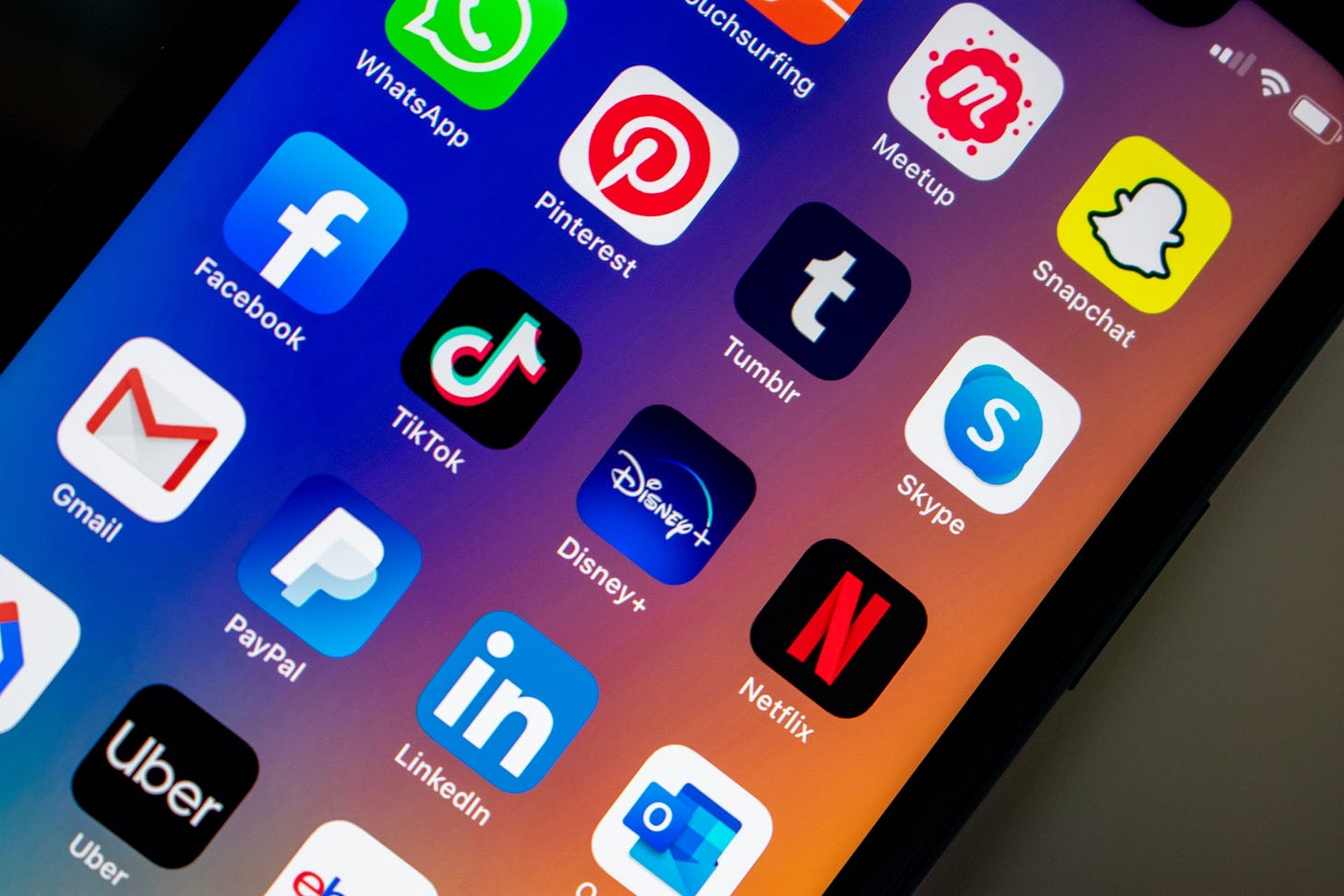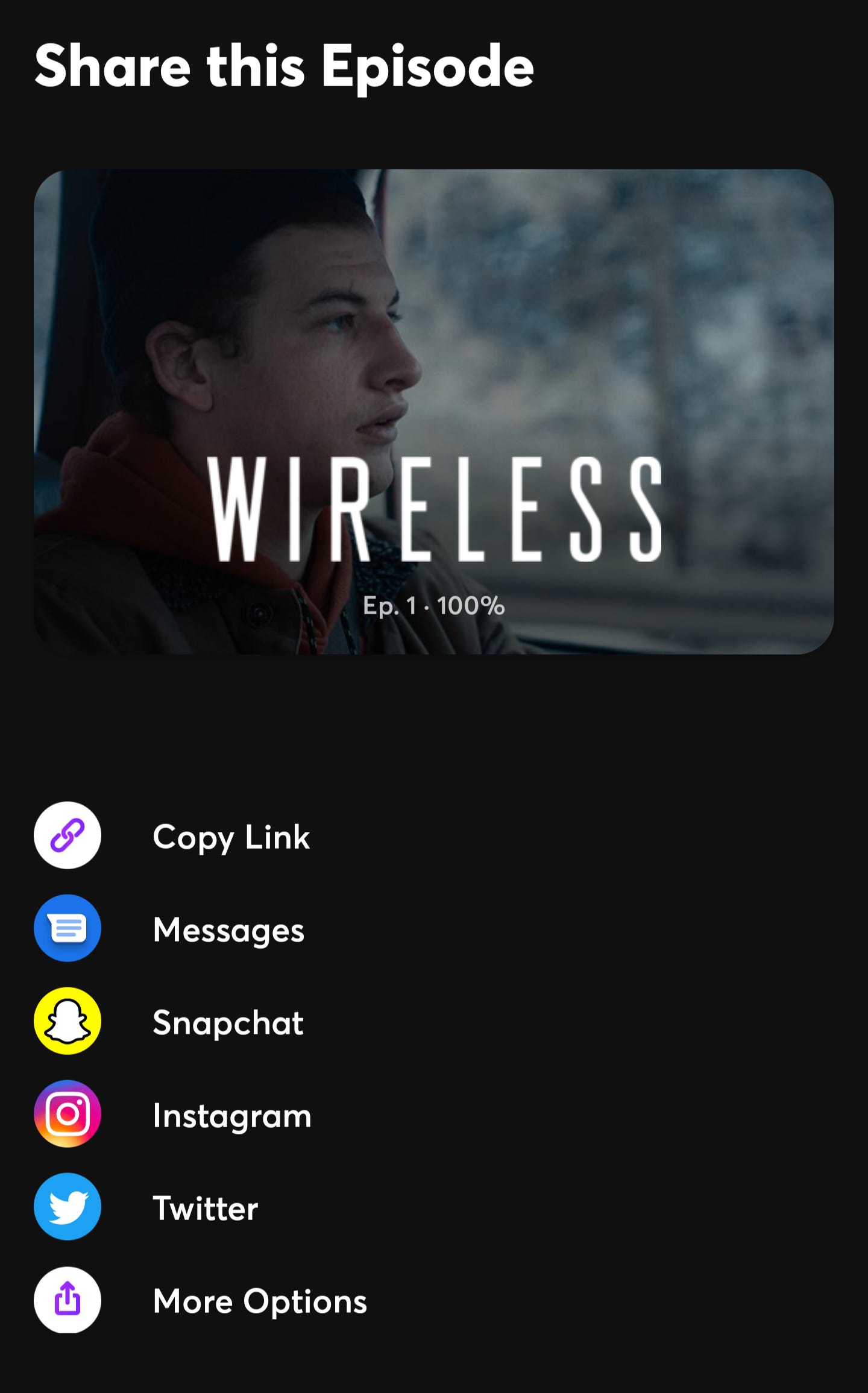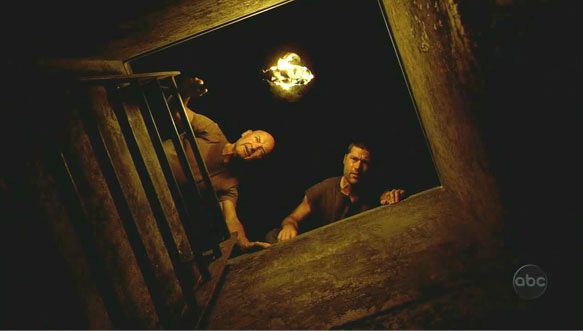Welcome back to Entertainment + Tech. Each week covers an interesting way technology & entertainment are colliding and where things might go from here.
Got a recommendation for a topic? Stray observation about a streaming platform that seems interesting? Let me know by responding to this email or reaching out on Twitter.
And if you’re new here, sign up to be the first to get future issues:

(Unsplash)
A while back, I made what I like to call the Nate Silver case for Quibi–while I wouldn’t say I’m confident of its success, I’m not as bearish as most others seem to be. (The beauty of taking that kind of stance is that I can claim victory no matter what happens.)
Keeping in mind that I have said nice things about the service before, let me point out my deepest disappointment with Quibi: it was built mobile-only, but it is the least social video platform I’ve ever seen.
Sure, there is a share button built right into the pause screen, but that’s a bare minimum effort. All it lets you do is share a link to the episode. Under what circumstance are they expecting me to tweet a direct link to Episode 4 of Most Dangerous Game, in the middle of watching it? [1]

I apologize to Quibi that my through line for this issue is going to be the ways I see them failing socially, but hey, the product is what the product is.
Let’s Give ‘Em Something To Talk About
Content is intertwined with social expression. It’s a major way we relate to & connect with other people. Content created by other people can help you express yourself.
In the most simple idea of social sharing, we do think about people sending links to content. That’s one important aspect, but there’s so much more. When I say social, I’m talking about all the ways that other people having watched something invariably gets you to watch it too.
Let’s talk about how social gets you to watch stuff, and why that’s easier for some kinds of content.
Social IRL
Before social media ever existed, content was still social. You talked about it around the water cooler. You watched it with other people.
106M people all watched the finale of M*A*S*H*–it probably came up in conversation. As Lost dropped bombshell after bombshell (sometimes literally), viewers went to their friends and the internet to puzzle out what was going on.

Cue ominous music. (Reddit)
If your friends are watching a show or if there’s conversation around it, you’re more likely give it a shot and stick with it. These conversations have now moved onto social media in a big way as well (we’ll get to this as well).
As I previously pointed out, social is a big driver for Netflix. One, it keeps the content top of mind, so when you log in to Netflix and see Tiger King, there’s a sense of recognition–you’re primed to watch it. Two, it creates a sense of FOMO, because you want to be part of that conversation too. One of Netflix’s biggest advantages is that everyone you know is watching it.
Content is more likely to drive this kind of social interaction if it’s popular, unexpected, timely, high-quality, really entertaining, etc. Obviously, it has to be worth having a conversation about.
Screen Time
Let’s talk more about watching with other people. We can think about a certain sociability for different methods of viewing:
If you’re watching in a theater, there will be lots of people around (in non-pandemic times), but most of them are strangers. [2]
If you’re watching on a TV at home, you can easily support a crowd of people you know. [3]
If you’re watching on your laptop, maybe two or three people can see comfortably.
If it’s on your phone, just you and maybe a weird guy watching over your shoulder on the bus.
It’s common to have a viewing squad for a particular show. You burn through Stranger Things with your roommate. [4] You get your snarkiest friends together every week to watch the latest Bachelorette. That social connection makes you more likely to continue watching or to jump in on something. Notably, these viewing parties are usually watched on TV–you want a larger device everyone can see comfortably.

Complaining about the GoT Finale is also a form of social connection. (WhatShouldWeDo)
Regarding Quibi, to the first point, no one else is watching the content & no one is talking about it. To the second, Quibi is only on the tiny screen of mobile. If I’m with friends, Quibi shows are not a viable option. These two are also related–the isolation of solitary viewing wouldn’t be so bad if you did have others to talk to afterwards. [5]
People are increasingly expecting mobile-first, but that’s only for certain tasks. When it comes to viewing high-quality content, people still want to watch on TVs and computers.
Made to Share
Certain types of content are easier to share. Why is that?
I found a write-up of an old NYT survey about why people share content online:
People want to better the lives of others (94%)
People want the content to reflect their online identity (68%)
People want to grow and nourish relationships (80%)
People share because they like the feeling of having others comment on it and engage (81%)
People want to spread the word about something that they believe in (84%)
- Psychology of Social Media: The Science Behind Why People Share Online - Meltwater.com
The motivations themselves are interesting, but they also have deeper implications for what content can reasonably be shared.
To fulfill those motivations, there’s a certain legibility the content needs to have in your Twitter feed or your group chat. TikTok videos are quick and have obvious points. You can share one and people will understand what it says about your identity. An episode of a Netflix show wouldn’t work as well–you could share your thoughts about it, but not the video itself (not even considering copyright issues).
Instead, we’ve seen ancillary types of content pop up, like clips and memes. Now, you can meet all those goals above with references to the content. They sound unassuming, but with GIFs, meme references, and images, fans drive conversation on social media.
How many people watched The Mandalorian because of the Baby Yoda gifs? How many people watched The Witcher because everyone was posting memes about tossing him a coin? I half-believe Schitt’s Creek won their billion Emmys off the GIFs that show produced.

If you need to own a Baby Yoda of your own, I found this image here. (Sideshow)
Having big, meme-able moments in your show means you can get your fans to do a lot of free marketing for you. I am curious to what extent content is already written to be GIF-fed and quoted. Regardless, the shows you’re more likely to hear about on social media are ones that are easy to share content from. [6]
On Quibi, you can’t clip or meme anything. You’re not allowed to take screenshots of the content. You can’t record snippets. As of May, they realized this was a mistake, but I haven’t seen a fix yet.
(NOTE - a reader pointed out that it is possible to screenshot now, it's just awkward and hidden: you have to tap and hold the screen, then swipe to the side. Not clear how many users actually know this, which might be why it hasn't seemed to make a difference. They couldn't use device screenshots for DRM reasons, but why not just make it available on the pause screen?)
Social Networking
So how can you use the power of social to get an audience?
If you’re a platform:
Recognize that the popularity of your service is a powerful flywheel.
Get people talking about the content with good social media management.
Make it easy for users to watch together.
Make it easy for people to create snippets from your platform’s content. They want to share their feelings and experiences with others.
Acquire good content, duh.
If you’re a creator:
Consider what hero moments fans will want to share & talk about.
Provide high-quality gifs & images so your fans can spread them.
Create good content, duh.
There’s also an opportunity to build products that make other content more social. Netflix Party (now called Teleparty) & Scener are building remote group-watching tools. As I mentioned in a footnote, Shuffle is making it easy to share podcast snippets. Find a way to help people share what they care about, and it turns out they’ll be sharing your product too.
And if you really like Entertainment + Tech, maybe pull a quote from this issue and share it?
———
[1] Especially problematic since no one can open it anyway if they’re not a Quibi subscriber.
[2] A Quiet Place is the most social movie experience I’ve ever had, and no one was talking. An incredible sense of audience connection as we maintained the silence & tension together.
[3] Somewhat similarly, when I worked on audio games for Google Assistant, we tried to keep in mind that multiple people would be hearing them. We wanted them to be fun for players and listeners. Games in general are rich for digging in this vein.
[4] Until you start Netflix Cheating.
[5] To be fair, Quibi did screen a drive-in movie, but that’s more marketing stunt than a scalable distribution method for them.
[6] You can see this trend in other media too. Shuffle is an app making podcasts social, and their clips have led more podcast content to come up in my Twitter feed. Genius created aesthetic Lyric Cards to make song quotes cooler to post.
Some Newsletters to Check Out
As I mentioned in my last, I joined On Deck’s first writing fellowship. We’re one week in and both the experience and community have been great!
Here are a couple of my fellow fellows’ newsletters I’ve enjoyed so far (more to come in following weeks):
White Noise by Tom White - Tom’s writing is personal, eclectic, always something interesting.
Negative One to Zero by Matt O’Brien - Personal lessons from Matt about working through hang-ups and living a better life.
Jungle Gym by Nick deWilde - Nick distills clear insights and frameworks to make you smarter and more effective.
Thanks for reading Entertainment + Tech. If you know someone else who would enjoy this newsletter, please share it with them!




This was a great read. I wonder what the relative impact of the lack of social features is compared to some of their other differentiating features (short-form, highly produced, experimental genres, one episode released every day, etc).